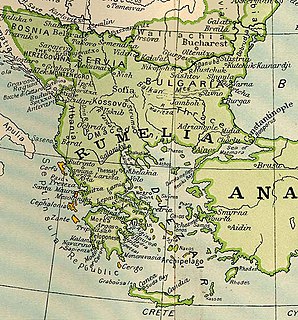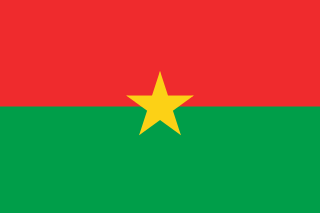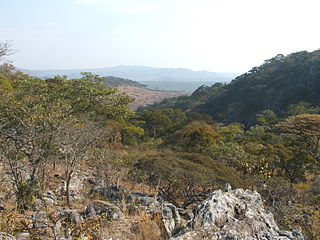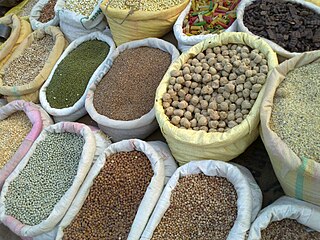
Millets (/ˈmɪlɪts/) are a group of highly variable small-seeded grasses, widely grown around the world as cereal crops or grains for fodder and human food.

Panicum miliaceum is a grain crop with many common names including proso millet, broomcorn millet, common millet,, hog millet, Kashfi millet red millet, and white millet,. Archeological evidence suggests that crop was first domesticated before 10,000 BCE in Northern China. The crop is extensively cultivated in China, India, Nepal, Russia, Ukraine, Belarus, the Middle East, Turkey, Romania, and the United States, where approximately half a million acres are grown each year. The crop is notable both for its extremely short lifespan, with some varieties producing grain only 60 days after planting, and its low water requirements producing grain more efficiently per unit of moisture than any other grain species tested. The name "proso millet" comes from the pan-Slavic general and generic name for millet Croatian: proso). Proso millet is a relative of foxtail millet, pearl millet, maize, and sorghum within the grass sub-family Panicoideae. While all of these crops utilize C4 photosynthesis, the others all employ the NADP-ME as their primary carbon shuttle pathway while the primary C4 carbon shuttle in proso millet is the NAD-ME pathway.

Eleusine coracana, or finger millet, is an annual herbaceous plant widely grown as a cereal crop in the arid and semiarid areas in Africa and Asia. It is a tetraploid and self-pollinating species probably evolved from its wild relative Eleusine africana.

Porridge is a food commonly eaten as a breakfast cereal dish, made by boiling ground, crushed or chopped starchy plants—typically grain—in water or milk. It is often cooked or served with added flavorings such as sugar, honey, fruit or syrup to make a sweet cereal or mixed with spices or vegetables to make a savoury dish. It is usually served hot in a bowl.

Noodles are unleavened dough which is stretched, extruded, or rolled flat and cut into one or a variety of shapes which usually include long, thin strips, or waves, helices, tubes, strings, or shells, or folded over, or cut into other shapes. Noodles are usually cooked in boiling water, sometimes with cooking oil or salt added. They are often pan-fried or deep-fried. Noodles can be served with an accompanying sauce or in a soup. Noodles can be refrigerated for short-term storage or dried and stored for future use. The material composition or geocultural origin must be specified when discussing noodles. Noodles are a staple food in many cultures.

Rumelia, also known as Turkey in Europe, was the name of a historical region in Southeast Europe that was administered by the Ottoman Empire, mainly the Balkan Peninsula. Rumelia included the provinces of Thrace, Macedonia and Moesia, today's Bulgaria and Turkish Thrace, bounded to the north by the rivers Sava and Danube, west by the Adriatic coast, and south by the Morea. Owing to administrative changes between 1870 and 1875, the name ceased to correspond to any political division. Eastern Rumelia was constituted as an autonomous province of the Ottoman Empire by the Treaty of Berlin in 1878. Today, in Turkey, the word Trakya (Thrace) has mostly replaced Rumeli (Rumelia) when referring to the part of Turkey which is in Europe, though Rumelia remains in use in some historical contexts.
In the Ottoman Empire, a millet was a separate court of law pertaining to "personal law" under which a confessional community was allowed to rule itself under its own laws. Despite frequently being referred to as a "system", before the nineteenth century the organization of what are now retrospectively called millets in the Ottoman Empire was far from systematic. Rather, non-Muslims were simply given a significant degree of autonomy within their own community, without an overarching structure for the 'millet' as a whole. The notion of distinct millets corresponding to different religious communities within the empire would not emerge until the eighteenth century. Subsequently, the existence of the millet system was justified through numerous foundation myths linking it back to the time of Sultan Mehmed the Conqueror, although it is now understood that no such system existed in the fifteenth century. After the Ottoman Tanzimat (1839–76) reforms, the term was used for legally protected religious minority groups, similar to the way other countries use the word nation. The word millet comes from the Arabic word millah (ملة) and literally means "nation". The millet system has been called an example of pre-modern religious pluralism.

Bhakri is a round flat unleavened bread often used in the cuisine of the states of Maharashtra, Gujarat, Karnataka and Goa in India, along with several regions of western and central India, including areas of Rajasthan, Malwa, and Karnataka. It is coarser than a regular wheat roti. A simple Roti also said to be Bhakari, in various places of Maharashtra. Hence, it may or may not be referred as the special made meal in case of wheat bhakri, i.e Chapati, Poli, etc. It can be either soft or hard in texture, similar to khakhra in respect to hardness.

Echinochloa frumentacea is a species of Echinochloa. Both Echinochloa frumentacea and E. esculenta are called Japanese millet. This millet is widely grown as a cereal in India, Pakistan, and Nepal. Its wild ancestor is the tropical grass Echinochloa colona, but the exact date or region of domestication is uncertain. It is cultivated on marginal lands where rice and other crops will not grow well. The grains are cooked in water, like rice, or boiled with milk and sugar. Sometimes it is fermented to make beer. While also being part of staple diet for some communities in India, these seeds are, in particular, eaten during religious fasting. For this reason, these seeds are commonly also referred to as "vrat ke chawal" in Hindi. Other common names to identify these seeds include oodalu (ಊದಲು) in KannadaJhangora in the Garhwal Hills, Bhagar (भगर) in Marathi speaking areas, Samo seeds, Morio / Mario / Moraiaya seeds. KuthiraiVaali (குதிரைவாளி)(Tamil)

Echinochloa is a very widespread genus of plants in the grass family. Some of the species are known by the common names barnyard grass or cockspur grass.

Echinochloa crus-galli is a type of wild grass originating from tropical Asia that was formerly classified as a type of panicum grass. It is commonly known as cockspur, barnyard millet, Japanese millet, water grass, common barnyard grass, or simply "barnyard grass". This plant can grow to 60" in height and has long, flat leaves which are often purplish at the base. Most stems are upright, but some will spread out over the ground. Stems are flattened at the base. The seed heads are a distinctive feature, often purplish, with large millet-like seeds in crowded spikelets.

The Cishan culture was a Neolithic culture in northern China, on the eastern foothills of the Taihang Mountains. The Cishan culture was based on the farming of broomcorn millet, the cultivation of which on one site has been dated back 10,000 years.
The people at Cishan also began to cultivate foxtail millet around 8700 years ago. However, these early dates have been questioned by some archaeologists due to sampling issues and lack of systematic surveying. There is also evidence that the Cishan people cultivated barley and, late in their history, a japonica variety of rice.

Millet beer, also known as Bantu beer, malwa, pombe "Tchouk" or opaque beer, is an alcoholic beverage made from malted millet that is common throughout Africa. Its production process varies across regions and in the southern parts of Africa is more commonly known as umqombothi. Millet Beer varies in taste and alcoholic content between ethnic groups. It is served in calabash gourds.

Burkinabé cuisine, the cuisine of Burkina Faso, is similar to the cuisines in many parts of West Africa, and is based on staple foods of sorghum, millet, rice, fonio, maize, peanuts, potatoes, beans, yams and okra. Rice, maize and millet are the most commonly eaten grains. Grilled meat is common, particularly mutton, goat, beef and fish. Vegetables include, besides yams and potatoes, okra, tomatoes, zucchini, carrots, leeks, onions, beets, pumpkins, cucumbers, cabbage, sorrel and spinach. Although imported products are becoming more common in urban areas, meals in more rural areas typically consist of tô, a sauce of corchorus or baobab leaves, as well as the calyx from Bombax costatum, dried fish, and spices such as chili and soumbala.

Sigurd or Siegfried is a legendary hero of Germanic mythology, who killed a dragon and was later murdered. It is possible he was inspired by one or more figures from the Frankish Merovingian dynasty, with Sigebert I being the most popular contender. Older scholarship sometimes connected him with Arminius, victor of the Battle of the Teutoburg Forest. He may also have a purely mythological origin. Sigurd's story is first attested on a series of carvings, including runestones from Sweden and stone crosses from the British Isles, dating from the eleventh century.

Chitemene, from the ciBemba word meaning “place where branches have been cut for a garden”, is a system of slash and burn agriculture practiced throughout northern Zambia. It involves coppicing or pollarding of standing trees in a primary or secondary growth Miombo woodland, stacking of the cut biomass, and eventual burning of the cut biomass in order to create a thicker layer of ash than would be possible with in situ burning. Crops such as maize, finger millet, sorghum, or cassava are then planted in the burned area.

A grain is a small, hard, dry seed, with or without an attached hull or fruit layer, harvested for human or animal consumption. A grain crop is a grain-producing plant. The two main types of commercial grain crops are cereals and legumes.

Chadian cuisine is the cooking traditions, practices, foods and dishes associated with the Republic of Chad. Chadians use a medium variety of grains, vegetables, fruits and meats. Commonly consumed grains include millet, sorghum, and rice as staple foods. Commonly eaten vegetables include okra and cassava. A variety of fruits are also eaten. Meats include mutton, chicken, pork, goat, fish, lamb and beef. The day's main meal is typically consumed in the evening on a large communal plate, with men and women usually eating in separate areas. This meal is typically served on the ground upon a mat, with people sitting and eating around it.

Guinea-Bissauan cuisine is the food culture of Guinea-Bissau, a nation on Africa's west coast along the Atlantic Ocean. Rice is a staple in the diet of residents near the coast and millet a staple in the interior. Much of the rice is imported and food insecurity is a problem in large part due to coups, corruption and inflation. Cashews are grown for export. Coconut, palm nut, and olives are also grown.

















